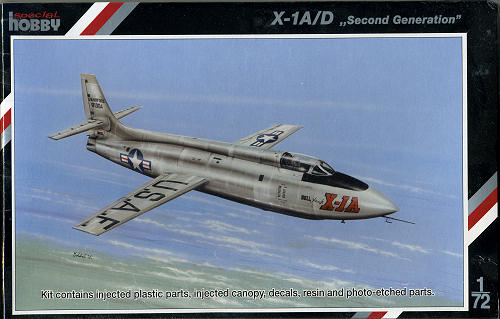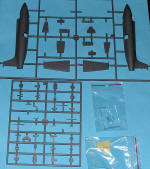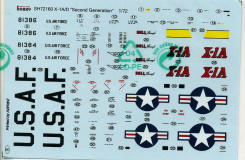
Special Hobby 1/72 Bell X-1A/D
| KIT #: | 72160 |
| PRICE: | $25.50 MSRP |
| DECALS: | Five options |
| REVIEWER: | Scott Van Aken |
| NOTES: | Short run with resin and photo etch parts |

| HISTORY |
X-1A
Ordered by the Air Force on 2 April1948, the X-1A (serial 48-1384) was intended to investigate aerodynamic phenomena at speeds above Mach 2 (681 m/s, 2,451 km/h) and altitudes greater than 90,000 feet (27 km), specifically focusing on dynamic stability and air loads. Longer and heavier than the original X-1, with a bubble canopy for better vision, the X-1A was powered by the same Reaction Motors XLR-11 rocket engine. The aircraft first flew, unpowered, on 14 February 1953 at Edwards AFB, with the first powered flight on 21 February. Both flights were piloted by Bell test pilot Jean Ziegler.
After NACA started its high-speed testing with the Douglas Skyrocket, culminating in Scott Crossfield achieving Mach 2.005 on 20 November 1953, the Air Force started a series of tests with the X-1A, which the test pilot of the series, Chuck Yeager, named "Operation NACA Weep". These culminated on 12 December1953, when Yeager achieved an altitude of 74,700 feet (22,770 m) and a new air speed record of Mach 2.44 (equal to 1620 mph, 724.5 m/s, 2608 km/h at that altitude). Unlike Crossfield in the Skyrocket, Yeager achieved that in level flight. Shortly after, the plane spun out of control, due to the then not yet understood phenomenon ofinertia coupling. The plane dropped from maximum altitude to 25,000 feet (7,620 m), exposing the pilot to accelerations of up to 8g, during which Yeager broke the canopy with his helmet before regaining control.
The aircraft was transferred to NACA in September 1954. Following modifications, including the installation of an ejection seat, the aircraft was lost on 8 August 1955 while being prepared for launch from the RB-50 mothership, becoming the first of many early X-planes that would be lost to explosions.
The X-1D (serial 48-1386) was the first of the second generation of supersonic rocket planes. Flown from an EB-50A (s/n #46-006), it was to be used for heat transfer research. The X-1D was equipped with a new low-pressure fuel system and a slightly increased fuel capacity. There were also some minor changes to the avionics set.
On 24 July 1951, with Bell test pilot Jean Ziegler at the controls, the X-1D was launched over Rogers Dry Lake, on what was to become the only successful flight of its career. The unpowered glide was completed after a nine-minute descent, but upon landing, the nose gear failed and the aircraft slid ungracefully to a stop. Repairs took several weeks to complete and a second flight was scheduled for mid-August. On 22 August 1951, the X-1D was lost in a fuel explosion during preparations for the first powered flight. The aircraft was destroyed upon impact after it was jettisoned from its EB-50A mothership.
| THE KIT |
 This 2007 kit is one of several X-planes released by MPM/Special Hobby. This is the first X-1A I can recall in any scale and the kit also provides the ability to do the short lived X-1D as well.
This 2007 kit is one of several X-planes released by MPM/Special Hobby. This is the first X-1A I can recall in any scale and the kit also provides the ability to do the short lived X-1D as well.
As you'd expect from modern MPM kits, the exterior molding is very nicely done. I'm thankful that MPM molded in the large elevator hinges as the thought of applying that in photo-etch is not a pleasant one. It wouldn't be an MPM kit without resin and photo etch. The resin is limited to the main wheel wells and a flat fairing aft of the nose well. Photo etch is mostly for the cockpit along with a few exterior bits. The cockpit is well done with sidewalls to add some additional detail. Thanks to the one piece wings and stabs, construction should go quickly. I was somewhat surprised that it has a separate rudder, but that my well have been done for trailing edge thinness.
 Instructions are well done as usual, with Gunze paint references. I was surprised that no nose weight information was provided. I'd add it in as the X-1 landing gear has a short wheelbase. The kit does come with a one-piece injected canopy that is a bit thick, but is clear enough to see interior details. Though only three pages are needed for construction, ten are needed for markings and decals. The X-1D and two of the X-1A options are identical in colors of unpainted metal and a white keel. The X-1A can also be done in overall orange or overall white. Decals are superbly printed by AviPrint and shown still in their sealed plastic bag.
Instructions are well done as usual, with Gunze paint references. I was surprised that no nose weight information was provided. I'd add it in as the X-1 landing gear has a short wheelbase. The kit does come with a one-piece injected canopy that is a bit thick, but is clear enough to see interior details. Though only three pages are needed for construction, ten are needed for markings and decals. The X-1D and two of the X-1A options are identical in colors of unpainted metal and a white keel. The X-1A can also be done in overall orange or overall white. Decals are superbly printed by AviPrint and shown still in their sealed plastic bag.
| CONCLUSIONS |
OK X-plane fans. I know many of you have been wanting this kit. I had to wait for the LHS to get in a second shipment for mine so it had to be in pretty high demand. It looks like a nice one and should help fill some shelf space for you who like these experimental types.
| REFERENCES |
January 2009
You can thank me and 'store credit' at CRM for this one.
If you would like your product reviewed fairly and fairly quickly, please contact the editor or see other details in the Note to Contributors.